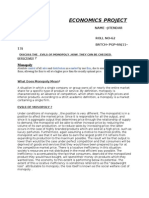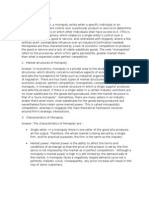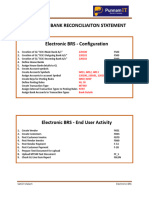0 ratings0% found this document useful (0 votes)
81 viewsMarket Structures - Part 3: Advantages Disadvantages Perfect Competition
Market Structures - Part 3: Advantages Disadvantages Perfect Competition
Uploaded by
kriston khanThe document discusses ways to control monopolies including nationalization, legislation and regulations, and price ceilings. It also compares the advantages and disadvantages of different market structures: perfect competition has efficiency but no economies of scale; monopolistic competition has variety but wasteful advertising; oligopolies can achieve economies of scale but collude; and monopolies achieve scale but exploit consumers with high prices and less innovation.
Copyright:
© All Rights Reserved
Available Formats
Download as DOCX, PDF, TXT or read online from Scribd
Market Structures - Part 3: Advantages Disadvantages Perfect Competition
Market Structures - Part 3: Advantages Disadvantages Perfect Competition
Uploaded by
kriston khan0 ratings0% found this document useful (0 votes)
81 views3 pagesThe document discusses ways to control monopolies including nationalization, legislation and regulations, and price ceilings. It also compares the advantages and disadvantages of different market structures: perfect competition has efficiency but no economies of scale; monopolistic competition has variety but wasteful advertising; oligopolies can achieve economies of scale but collude; and monopolies achieve scale but exploit consumers with high prices and less innovation.
Original Title
econ 12
Copyright
© © All Rights Reserved
Available Formats
DOCX, PDF, TXT or read online from Scribd
Share this document
Did you find this document useful?
Is this content inappropriate?
The document discusses ways to control monopolies including nationalization, legislation and regulations, and price ceilings. It also compares the advantages and disadvantages of different market structures: perfect competition has efficiency but no economies of scale; monopolistic competition has variety but wasteful advertising; oligopolies can achieve economies of scale but collude; and monopolies achieve scale but exploit consumers with high prices and less innovation.
Copyright:
© All Rights Reserved
Available Formats
Download as DOCX, PDF, TXT or read online from Scribd
Download as docx, pdf, or txt
0 ratings0% found this document useful (0 votes)
81 views3 pagesMarket Structures - Part 3: Advantages Disadvantages Perfect Competition
Market Structures - Part 3: Advantages Disadvantages Perfect Competition
Uploaded by
kriston khanThe document discusses ways to control monopolies including nationalization, legislation and regulations, and price ceilings. It also compares the advantages and disadvantages of different market structures: perfect competition has efficiency but no economies of scale; monopolistic competition has variety but wasteful advertising; oligopolies can achieve economies of scale but collude; and monopolies achieve scale but exploit consumers with high prices and less innovation.
Copyright:
© All Rights Reserved
Available Formats
Download as DOCX, PDF, TXT or read online from Scribd
Download as docx, pdf, or txt
You are on page 1of 3
Market Structures – part 3
Ways to control a monopoly:
Nationalization – government buying the monopoly from the private sector,
so that it (the government) can choose prices and output levels that benefit
society.
Legislation (laws) and regulations (rules) and taxes – all designed to restrict
how much the monopoly can grow or how much it can exploit consumers.
Price ceilings (maximum price) – designed to limit the high prices that a
monopoly can charge.
Advantages and disadvantages of each market structure
Advantages Disadvantages
Perfect Efficiency No economies of
Competition Lower prices scale
Consumer sovereignty No abnormal profits
No money spent on in the long run
advertising because No research &
there is perfect development
knowledge. (because there aren’t
No firm has monopoly enough profits to pay
power for it)
Monopolistic Greater consumer No efficiency
Competition choice (variety of Money is spent on
goods and services to advertising, thus cost
choose from) of production
There is innovation, as increases
firms compete with There might be
each other to make wastage e.g. too
better products much packaging for a
No firm has monopoly simple product
power No abnormal profits
Advertising gives in the long run
consumers more No research &
knowledge about development
products (because there aren’t
profits to pay for
them)
Advertising can be
misleading
Oligopoly Economies of scale No efficiency
They can afford to pay They can collude and
for research & form cartels which
development have monopoly
Abnormal profits in power
both the short run Less variety for
and long run consumers
Prices can be stable Higher prices
since the firms won’t because there is less
easily deviate from competition
what is already being
charged (the price at
the bend or kink)
More tax revenue for
the government
Monopoly Economies of scale Exploitation of
They can pay for consumers by
research & charging higher
development prices and producing
They can pay for new less output
technology Customer service
Abnormal profits in might not be the best
both the short run Quality of the
and long run product might not be
More tax revenue for the best
the government Price discrimination
(charging different
prices to different
consumers)
Unfair trade practices
to block other firms
from entering the
market (such as
predatory pricing).
Inequality of wealth,
since the monopolist
gets wealthier at the
expense of
customers
No efficiency
Potential for
diseconomies of
scale if it expands too
much
Less motivation to be
innovative
No choice/variety for
consumers
Monopolies might
gain political
influence
You might also like
- Summary: Information Rules: Review and Analysis of Shapiro and Varian's BookFrom EverandSummary: Information Rules: Review and Analysis of Shapiro and Varian's BookRating: 4 out of 5 stars4/5 (1)
- Philosophy of The Product - The Material Cause of Business (Part 1)Document5 pagesPhilosophy of The Product - The Material Cause of Business (Part 1)Karl Jason Dolar Comin100% (1)
- Market StructureDocument3 pagesMarket StructurequratulainNo ratings yet
- P2 Market StructuresDocument4 pagesP2 Market StructuresHashir ShaheerNo ratings yet
- Why Monopoly Can Be HarmDocument5 pagesWhy Monopoly Can Be Harmzakuan79No ratings yet
- 3.8 - Market StructureDocument3 pages3.8 - Market Structuremuhammad umairNo ratings yet
- Market StructureDocument4 pagesMarket StructureBlack DarkNo ratings yet
- Economics ProjectDocument3 pagesEconomics ProjectSunil BandiNo ratings yet
- Term Paper On OligopolyDocument5 pagesTerm Paper On Oligopolyafdtygyhk100% (1)
- International TradeDocument3 pagesInternational TradeBashar RoveziNo ratings yet
- Case Study: Competitive ForcesDocument3 pagesCase Study: Competitive ForcesArif QureshiNo ratings yet
- Economics Exam Notes - MonopolyDocument5 pagesEconomics Exam Notes - MonopolyDistingNo ratings yet
- 5 - The Role of Government N Adv, Disa of MonopolDocument11 pages5 - The Role of Government N Adv, Disa of Monopoldestinyebeku01No ratings yet
- Competition Course (Day 1-Introduction To Competition Law) - LNT - 13jul2020...Document24 pagesCompetition Course (Day 1-Introduction To Competition Law) - LNT - 13jul2020...Sao Nguyễn ToànNo ratings yet
- Analysis of Monopolistically Competitive MarketDocument4 pagesAnalysis of Monopolistically Competitive MarketQueensenNo ratings yet
- Oligopoly SolutionDocument2 pagesOligopoly SolutioniqmobiletutorNo ratings yet
- MonopolyDocument3 pagesMonopolyHaseeb WaheedNo ratings yet
- Eco Term PaperDocument21 pagesEco Term PapersonysamsungNo ratings yet
- Market StructureDocument24 pagesMarket StructureSyed Ali TurabNo ratings yet
- Market StructureDocument73 pagesMarket StructureKim Tiu100% (1)
- Monopoly PDFDocument3 pagesMonopoly PDFWaleed AbbasiNo ratings yet
- How Does Each Market Structure Benefit Consumers?: Made by Oleguer Roca PuigDocument7 pagesHow Does Each Market Structure Benefit Consumers?: Made by Oleguer Roca PuigoleguerrocaNo ratings yet
- Types of MonopoliesDocument8 pagesTypes of MonopoliesMuzna AijazNo ratings yet
- T4. InnovationDocument5 pagesT4. InnovationNothing ThereNo ratings yet
- Theory of Market: Perfect Competition: Nature and Relevance Monopoly and Monopolistic Competition OligopolyDocument18 pagesTheory of Market: Perfect Competition: Nature and Relevance Monopoly and Monopolistic Competition OligopolyDivyanshu BargaliNo ratings yet
- Monopoly: Rodman T. Cajes SEPTEMBER 10, 2021 Adapted From Boundless EconomicsDocument27 pagesMonopoly: Rodman T. Cajes SEPTEMBER 10, 2021 Adapted From Boundless EconomicsMIKE ARTHUR DAVIDNo ratings yet
- Moats Morning StarDocument9 pagesMoats Morning StarDavid Felipe Arango GuzmánNo ratings yet
- Oligopoly NotesDocument4 pagesOligopoly NotesHarry FishNo ratings yet
- Monopolistic CompetitionDocument4 pagesMonopolistic CompetitionCookie LayugNo ratings yet
- NATIONALISATIONDocument2 pagesNATIONALISATIONKien VuNo ratings yet
- CompetitionDocument13 pagesCompetitionFaizan AhmedNo ratings yet
- Porter's Five Forces ModelDocument8 pagesPorter's Five Forces Modelharpreet kaurNo ratings yet
- Nataliemoore MonopoliesDocument1 pageNataliemoore Monopoliessnehilhaldar1998No ratings yet
- Assignment of Managerial Economy: Mohamed Omar MahamoudDocument8 pagesAssignment of Managerial Economy: Mohamed Omar MahamoudMohamed OmarionNo ratings yet
- The Barriers To Entry and ExitDocument3 pagesThe Barriers To Entry and ExitRashed SifatNo ratings yet
- ECO 204 Final PaperDocument9 pagesECO 204 Final Paperfields169No ratings yet
- CIE IGCSE Unit 3.8 - Competition and Market Structures - Miss PatelDocument24 pagesCIE IGCSE Unit 3.8 - Competition and Market Structures - Miss PatelJingyao HanNo ratings yet
- Porter ModelDocument14 pagesPorter ModeladitiNo ratings yet
- Quantity Demanded/% Change in Price Lerner Index: (P-MC) /P: Enterprise TakeawaysDocument2 pagesQuantity Demanded/% Change in Price Lerner Index: (P-MC) /P: Enterprise TakeawaysDGNo ratings yet
- Actividad Electiva Las 5 FuerzasDocument4 pagesActividad Electiva Las 5 FuerzasBrenda MarroquinNo ratings yet
- (ECON 124) Chapter 6Document5 pages(ECON 124) Chapter 6rorNo ratings yet
- Understanding The Tool: Porter's Five Forces ModelDocument10 pagesUnderstanding The Tool: Porter's Five Forces ModelsherdarazNo ratings yet
- Chapter Monopolistic CompetitionDocument3 pagesChapter Monopolistic CompetitionRashed SifatNo ratings yet
- Competitors AnalysisDocument8 pagesCompetitors AnalysisDarshan ShahNo ratings yet
- MonopolyDocument6 pagesMonopolyRian RianNo ratings yet
- Monopoly Market-NotesDocument97 pagesMonopoly Market-NotesSumaiya KermaliNo ratings yet
- Summary Final MicroeconomicsDocument16 pagesSummary Final MicroeconomicsepostliahNo ratings yet
- Chapter 10 ReportDocument29 pagesChapter 10 ReportMay Jude Dela CruzNo ratings yet
- 5 Business Handout 2022-2023 PDFDocument18 pages5 Business Handout 2022-2023 PDFlemoniteNo ratings yet
- Business Economics Final Exam Study GuideDocument8 pagesBusiness Economics Final Exam Study GuideAnnaNo ratings yet
- What Are The Five Forces Session 2 Lecture NotesDocument9 pagesWhat Are The Five Forces Session 2 Lecture NotesMuse ManiaNo ratings yet
- Opportunities & Threats - Analyzing The External EnvironmentDocument4 pagesOpportunities & Threats - Analyzing The External EnvironmentMaeNo ratings yet
- Profit MaximizationDocument2 pagesProfit MaximizationChristian SamsonNo ratings yet
- How Important Are The Following in Making DecisionsDocument4 pagesHow Important Are The Following in Making DecisionsJAYLE KANZ LEALNo ratings yet
- Monopoly in IRDocument17 pagesMonopoly in IRakashNo ratings yet
- Changes With Marginal Utility Held ConstantDocument6 pagesChanges With Marginal Utility Held ConstanthyNo ratings yet
- Q 9 & 10 - 1Document13 pagesQ 9 & 10 - 1zaainmariyam12No ratings yet
- Monopolies That Make Super Normal Profits Are Always Against Public Interest Because They Could Charge A Lower Price Than They DoDocument4 pagesMonopolies That Make Super Normal Profits Are Always Against Public Interest Because They Could Charge A Lower Price Than They DohotungsonNo ratings yet
- 42 ECO SAT-1 From Vikash AgrawalDocument12 pages42 ECO SAT-1 From Vikash AgrawalVikash AgrawalNo ratings yet
- Econ202 Chapter 22Document11 pagesEcon202 Chapter 22Wassup WasabiNo ratings yet
- Chapter 1: Introduction To EntrepreneurshipDocument16 pagesChapter 1: Introduction To EntrepreneurshipMichael Di MonacoNo ratings yet
- Sample Maths SBA Project, Linear ProgrammingDocument11 pagesSample Maths SBA Project, Linear Programmingkriston khanNo ratings yet
- 21-22 Pres CSEC IT SBADocument7 pages21-22 Pres CSEC IT SBAkriston khanNo ratings yet
- CSEC Physics MCQ AnswersDocument1 pageCSEC Physics MCQ Answerskriston khanNo ratings yet
- Brandon's ENGLISH SBADocument15 pagesBrandon's ENGLISH SBAkriston khan50% (2)
- Caribbean CSEC Physics Study Guide-1Document196 pagesCaribbean CSEC Physics Study Guide-1kriston khanNo ratings yet
- Summary and Analysis of Chapters 4-7: To Kill A Mockingbird-Harper LeeDocument3 pagesSummary and Analysis of Chapters 4-7: To Kill A Mockingbird-Harper Leekriston khanNo ratings yet
- EngSBA AlmostdoneDocument13 pagesEngSBA Almostdonekriston khanNo ratings yet
- Heat & Thermal MeasurementsDocument47 pagesHeat & Thermal Measurementskriston khanNo ratings yet
- You Are The BrandDocument12 pagesYou Are The BrandAbera TeshomeNo ratings yet
- Capital Expenditure & Revenue Expenditure ExerciseDocument21 pagesCapital Expenditure & Revenue Expenditure ExerciseASMARA HABIBNo ratings yet
- Non Disclosure AgreementDocument2 pagesNon Disclosure AgreementIvy Maines DiazNo ratings yet
- Financial System: Course ObjectiveDocument2 pagesFinancial System: Course ObjectiveAnonymous 8aj9gk7GCLNo ratings yet
- SALE of GOODS ACT, 1930 Performance of Contract of SaleDocument7 pagesSALE of GOODS ACT, 1930 Performance of Contract of SaleBiruk YidnekachewNo ratings yet
- The Scope of Operations ManagementDocument17 pagesThe Scope of Operations Managementgiezele ballatanNo ratings yet
- May 2017 Advanced Financial Accounting & Reporting Final Pre-BoardDocument20 pagesMay 2017 Advanced Financial Accounting & Reporting Final Pre-BoardPatrick ArazoNo ratings yet
- Hotel Development Cost Survey 2023Document16 pagesHotel Development Cost Survey 2023alim shaikhNo ratings yet
- CPSB Service Charter 1Document3 pagesCPSB Service Charter 1Nathaniel Ochieng WanyangaNo ratings yet
- LightUP Oakland ProposalDocument240 pagesLightUP Oakland ProposalCyrus FarivarNo ratings yet
- UniformDocument3 pagesUniformKaty OlidanNo ratings yet
- Chapter 4 EMDocument18 pagesChapter 4 EMANTENNA FFNo ratings yet
- 018 Project Electronic BRSDocument34 pages018 Project Electronic BRSAkshay GodhamgaonkarNo ratings yet
- Financial ParametersDocument43 pagesFinancial ParametersJivaansha SinhaNo ratings yet
- RC 2023 Winning Written Report University of SydneyDocument21 pagesRC 2023 Winning Written Report University of SydneyzeehenNo ratings yet
- Contentious Issues in GST 11.10.2018Document24 pagesContentious Issues in GST 11.10.2018Bathina Srinivasa RaoNo ratings yet
- Chapter 11, Part B Inventory Models: Probabilistic DemandDocument25 pagesChapter 11, Part B Inventory Models: Probabilistic DemandPankaj VermaNo ratings yet
- REFLECTIONS and CASE STUDYDocument14 pagesREFLECTIONS and CASE STUDYLillyVtNo ratings yet
- Case 07: R. MarleneDocument7 pagesCase 07: R. MarleneAnonymous bV4OSINo ratings yet
- Group Global Vision Unilever Case StudyDocument63 pagesGroup Global Vision Unilever Case Studydee4dNo ratings yet
- National Salaries, Incomes and Wages Commission PDFDocument2 pagesNational Salaries, Incomes and Wages Commission PDFFortune Nwachukwu OnweNo ratings yet
- Chapter 7 - The Project Schedule and BudgetDocument20 pagesChapter 7 - The Project Schedule and BudgetJasha Alexi FuentesNo ratings yet
- Ryu 2010Document29 pagesRyu 2010Waqas DarNo ratings yet
- Econ 442 - Problem Set 3Document6 pagesEcon 442 - Problem Set 3Nguyễn Hải GiangNo ratings yet
- GRP 1 Financial-Market-Intro-TypesDocument34 pagesGRP 1 Financial-Market-Intro-TypesXander C. PasionNo ratings yet
- Everything To Know About Customer Lifetime Value - Ebook PDFDocument28 pagesEverything To Know About Customer Lifetime Value - Ebook PDFNishi GoyalNo ratings yet
- MoU - Land Registry IndonesiaDocument4 pagesMoU - Land Registry IndonesiaErvan NafisNo ratings yet
- Oppo Marketing Strategies by Vinay Main File Minor ProjectDocument91 pagesOppo Marketing Strategies by Vinay Main File Minor Projectvinay100% (2)
- Hrelective Project Ruppal Agarwal PDFDocument8 pagesHrelective Project Ruppal Agarwal PDFKrishnendu GhoshNo ratings yet

































































































